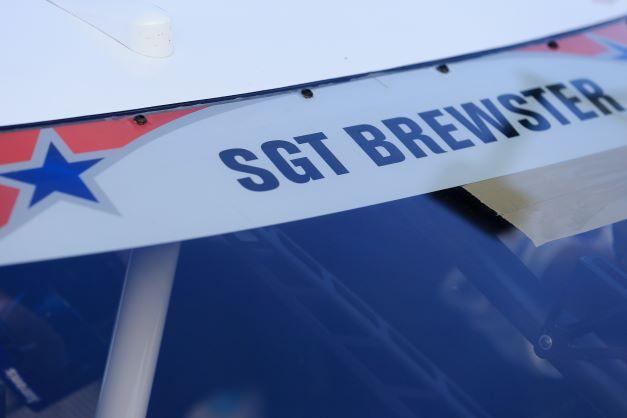NASCAR’s Pioneers Served Our Country
by Tom Jensen February 09, 2023
Long-running relationship between NASCAR and the U.S. military has deep roots that continue to this day
The NASCAR community and the U.S. military have long had a close-knit relationship.
Many of the racers who competed in NASCAR’s first season of 1948 had also served their country in World War II. The bond between the sport and the service is as strong today and was strong in the sport’s infancy. Military flyovers have been featured at NASCAR races since the sanctioning body ran on the white sands of Daytona Beach in the 1950s.

The United States Air Force Thunderbirds performed a flyover at Daytona Beach before the start of the NASCAR Modified Division race on February 15, 1957. Photo courtesy of NASCAR Archives & Research Center via Getty Images
Every Memorial Day, thousands of soldiers file into Charlotte Motor Speedway for a tribute to their fallen comrades. Elaborate pre-race shows feature military themes for the sport’s most somber holiday. Every car that races at Charlotte during Memorial Day weekend carries the name of a service member killed in the line of duty.

The pre-race ceremonies for the Coca-Cola 600 at Charlotte Motor Speedway salute the armed services members who paid the ultimate price defending our country. Photo courtesy of Jeff Zelevansky/NASCAR via Getty Images
The NASCAR Hall of Fame offers admission discounts to active-duty military members, as do many of the tracks on the circuit. “Holidays for Heroes,” an annual program between Toyota and the Hall of Fame supports both active and veteran military families with donations to Veterans Bridge Home, a Charlotte-based organization.

U.S. Army Sergeant Bryan Brewster, who perished in a helicopter crash near the Afghanistan-Pakistan Border in 2006, was honored during the 2015 Coca-Cola 600. Photo courtesy of Daniel Shirey/Getty Images
Numerous tracks, teams and drivers also do charitable work with veterans, either through special programs, foundations or both. And every branch of the U.S. military has participated in the sport by being a sponsor at least once.

For the 1991 Daytona 500, five cars carried military sponsorship as a tribute to those serving in Operation Desert Storm. From left: No. 24 Mickey Gibbs (Air Force), No. 18 Greg Sacks (Navy), No. 7 Alan Kulwicki (Army), No. 88 Buddy Baker (Marine Corps) and No. 71 Dave Marcis (Coast Guard). Photo courtesy of NASCAR Archives & Research Center via Getty Images
As an industry, NASCAR and its millions of fans have a deep level of appreciation for the contributions and sacrifices of the men and women of the armed forces and their families.
The connection began in NASCAR’s inaugural season of 1948, when a pair of World War II veterans, who would go on to Hall of Fame careers, hit it big. Driver Red Byron, a member of the Class of 2018, won the Modified Division (now Whelen Modified Tour) title, and a year later, Byron won the first Strictly Stock Division (now premier series) championship. His car owner in both his championship seasons was Atlanta businessman Raymond Parks (Class of 2017). Both men had distinguished military careers.

Before becoming a two-time championship NASCAR team owner, Raymond Parks served in the U.S. Army during World War II. NASCAR Permanent Collection, gift of Violet Parks.
Parks was a U.S. Army soldier who fought in the Battle of the Bulge, the last major European Theater land battle of World War II, while Byron was a flight engineer on a U.S. Army Air Corps B-24 Liberator bomber. Seriously injured during a bombing run over the Aleutian Islands, Byron spent 27 months in a Colorado hospital recuperating from serious leg wounds. For the rest of his career, Byron would race with his left-leg brace bolted to his clutch pedal.

Bud Moore was a highly decorated soldier in World War II. Photo courtesy of NASCAR Archives & Research Center via Getty Images
Parks and Byron weren’t the only racers to fight in World War II. Bud Moore (Class of 2011) was drafted as an 18-year-old in 1943, and a year later participated in D-Day as a member of the U.S. Army’s 4th Infantry Division. Like Parks, Moore fought the Germans through the winter of 1944 and into 1945. For his service, Moore received two Bronze Stars for valor and five Purple Hearts for wounds he received in combat. Moore’s medals are on display in the NASCAR Hall of Fame’s Heritage Speedway.
Two Hall of Fame crew chiefs also served in the Army after the war. Dale Inman (Class of 2012) served from 1959 to 1961 as an ordinance specialist. The organizational skills Inman learned in the Army certainly helped him on his way to being the only crew chief in NASCAR history to win eight premier series championships.
Leonard Wood (Class of 2013), a contemporary and competitor of Inman’s, worked as a mechanic when he served in the Army in the 1950s, where he doubtless had the motor pool running in top form.

A military flyover is both a salute to the United States armed forces and a traditional way to conclude Daytona 500 pre-race ceremonies. Photo courtesy of NASCAR Archives & Research Center via Getty Images
That rich heritage continues in present-day NASCAR racing. Throughout the NASCAR industry, military veterans are employed in various jobs at track, in the shops and among the many businesses that support the sport.

Members of the military stand at attention prior to the Coca-Cola 600 at Charlotte Motor Speedway. Photo courtesy of Matt Sullivan/Getty Images
Plan your visit to the NASCAR Hall of Fame and purchase tickets by visiting nascarhall.com/tickets.













